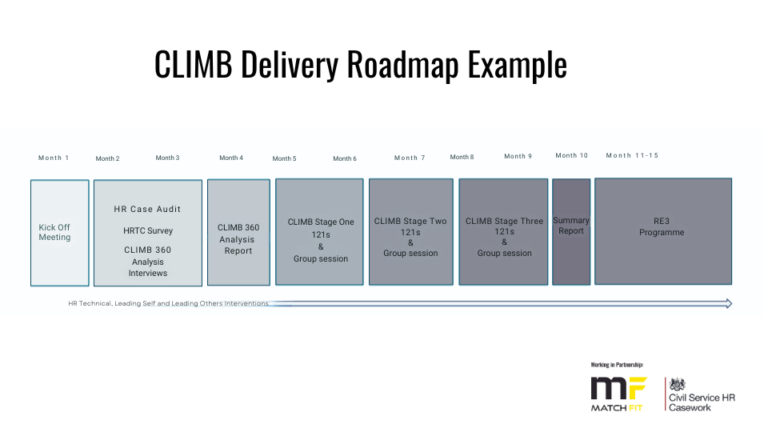By Bradley Honnor
Creating and sustaining a culture of high-performance whilst ensuring an inclusive environment of diversity of thought and background can be challenging for organisations to navigate. MatchFit have always believed passionately that the key to solving this dilemma is a thorough understanding of an organisation from all perspectives, which is why every programme we deliver begins with a CLIMB 360 Analysis.
But what is CLIMB 360 Analysis, and how does it impact the outcomes for clients? One example is evidenced by our partnership with the Civil Service HR Casework team to form the multiple award-winning HR Technical Consultancy (HRTC), which uses CLIMB and other MatchFit products as an essential element of its service.
Why CLIMB 360 Analysis?
Fundamentally, the goal of CLIMB 360 Analysis is to thoroughly understand the perceptions of individuals that work within a business or a team. It seeks to deeply understand individual perspectives, for example, what it’s like to work there and how it feels. It asks for people’s views on communication, leadership and the culture, and seeks to obtain a thorough sense of what staff feel is working and what needs to change in order to make the culture, leadership and communication more effective.
We always start with the CLIMB 360 Analysis process because we cannot and should not assume that we know and understand exactly what needs to be addressed; that the priorities are the right ones. How can we take a team or organisation to the next level of performance without actually speaking to the people that work in it and understanding their current perspectives and challenges? Quite often, one outcome of the analysis is that the commissioning leadership will have some of their beliefs and expectations confirmed. But equally, there are often surprises; insights that they were not expecting at all.
Seeking perspectives
For a programme to be effective, we can’t just rely on leadership to commission the work – we need to seek the perspectives of others in the organisation, with whom we conduct confidential, one-to-one conversations via our skilled consultants. To solicit the widest range of views possible, we ask the leadership team to select 12 diverse people. We request that this includes staff at different levels of seniority; maybe who have just joined the organisation and those who have been there a long time. We ask for diverse backgrounds and identities to be represented. And we specifically ask for the ‘disgruntled and the evangelical’.
Because confidentiality is ensured throughout the process (and the fact that we are an external organisation) people feel safe to speak openly and honestly. This means we gather a really broad range of views and opinions around specific questions that are non-directive and non-leading. What emerges from these conversations is the discovery of what people are actually thinking; what’s on their minds. We see themes emerging and the real issues that everyone is talking about. This way, we can identify the challenges that need to be overcome, and the elements that are working and need to be reinforced.
Views in tandem
Alongside the CLIMB 360 Analysis, HRTC run a bespoke organisation-wide survey which reflects very similar questions. We then compare the CLIMB analysis responses with the survey.
In addition, a skilled HR case management audit is conducted. This is where an HR Case Manager sits with management and examines every outstanding HR case – for example, every grievance, every disciplinary, past and present. They look at how quickly and professionally past cases have been concluded, the outcomes and how best to resolve the outstanding current cases. The objective is to provide a strategy which supports managers and leadership to conclude the cases professionally; to recognise what’s worked before, and take into account their risk appetite in terms of resolution. The case manager can then advise how to progress the case.
These three elements run together to provide what we term ‘Cultural Immersion’. Collectively, they allow us to achieve a genuine insight into how the organisation is really operating. This information is then fed back to the leadership in the form of a full report that outlines (anonymously) the themes drawn from the conversations that will result in better leadership and management, and move the needle in terms of organisational high performance.
MatchFit have always worked in this way because we have a deep-seated belief in the importance of getting underneath the surface, behind the scenes of what’s going on in an organisation. This is also a reason why the HRTC partnership works so well, because SC HR Casework have a similar passion for evidence-based practice.
Measuring outcomes
This approach makes a huge difference to overall outcomes, because in the report, we can specify what the focus of actions should be and what outcomes can be expected. From that analysis, we’re able to benchmark and measure the process moving forward. There’s a stake in the ground stating ‘this is where you started, this is what we’re doing, and this is the change needed’. The leadership can then priorities and shape their own direction for progress. Not only can we then look back at the end of the programme and ask if we were successful – we can also adjust as required during the journey. This ability to measure is invaluable.
As the programme itself progresses we actually measure at four different levels. We measure how people are reacting – are they finding value in the process? We measure what they have learned – what insights have they gained that they didn’t have before they engaged in the process? And we measure behaviour – what have they been doing differently based on what they’ve learned? Finally, we measure what the impact is on the organisation of doing things differently.
We tend to find evidence for the first three levels via the CLIMB 360 Analysis, HR bespoke survey and Case management audit. When we, as HRTC, conduct this Cultural Immersion and feed the analysis report back to the leadership team, we can identify whether there’s value in the process; is this information useful? Are you gaining insights? Did you know this already? Is this new to you? What are you learning about your own organisation?
We can then advise what they need start thinking about as the programme moves forward: what are the priorities for doing things differently, what are the interventions that are needed to effect change. The analysis helps us to not only identify the dimension of the CLIMB programme, but also helps us identify the interventions to be delivered.
Collaborative working
Throughout the programme, we’re not only working with people individually, we’re working with them as a group. We really get to understand them, and their challenges. That might be, for example, a manager talking about the need to upskill their own team in certain areas. So the process by definition, also uncovers areas that need additional input.
Because we work through and wholly in partnership, the access to data and material we can use to benchmark and evidence each programme’s success is unprecedented. If MatchFit was just a supplier, we wouldn’t have access to that confidential information. But because we’re working in partnership, we work together to demonstrate the success of the CLIMB programme.
Even from stage one of the CLIMB programme, we can start to see a positive impact on an organisation. For example, a disciplinary might historically have taken 18 months to conclude, whereas now it only takes seven months, because the managers have been upskilled through the HRTC technical interventions.
Being able to measure the impact so clearly is unusual. And it’s a key reason the HRTC partnership is award-winning – because we can visibly demonstrate the path towards high performance.

If you’d like to learn more about our MatchFit programmes, take a look at our information pages here, or why not get in touch? [email protected]

